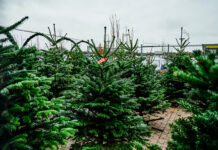Lush green and soft enough to fall asleep on. Those were the hallmarks of a great lawn when I was growing up in the upper Midwest. When the snow finally melted after months of sometimes- brutal winter, regenerating luxurious lawns was one of the rites of spring. Pristine images of expansive glowing green lawns, turf builder products and smiling faces on riding mowers filled the TV screen. The smell of freshly mowed grass was a touchstone of summer.
Moving to Southern California brought a rude awakening. Architecture, trees, lawns – everything was different. The grasses aren’t as green and definitely aren’t as soft; sometimes they’re downright prickly. Lawns just didn’t look and feel quite right.
And then there were the houses where lawn had been replaced … with gravel or sand and ground cover and strange vegetation. My first thought was those yards looked exotic and alien – like the plants and landscapes in the Desert Dome at the indoor botanical gardens back home. Maybe that made some kind of cosmic sense; those were the days during Jerry Brown’s first stint as governor when he was known to many as Governor Moonbeam.
I spent a lot of years longing for the lusher greens. Almost every time I left L.A. I would notice how much greener it is elsewhere. It’s human nature to seek to re-create environments we’re used to and comfortable with…and I was a great practitioner.
Along the way we’ve lived through a number of droughts, accompanied by reminders about the impact of excessive lawn watering. That’s when I first heard about drought tolerant plants, which often require little or no watering during winter months and substantially less watering than other plants during hot and dry months.
Over time I noticed more households eschewing conventional lawns for native vegetation, in ever more varied and interesting ways. Friends slowly opened my eyes to the stark beauty of semi-arid and desert landscapes.
Now that we’re in the middle of another severe drought (recent thunderstorms notwithstanding), lawns are front and center again. It’s estimated that between 40 and 60 percent of the yearly water use by the average Southern California household is for watering lawns, plants and shrubs. Replacing even part of a lawn with drought-resistant landscaping offers the opportunity to significantly reduce water consumption, and to conserve water for the long term.
And there are additional benefits. According to the Environmental Programs Division of the L.A. County Department of Public Works, using California native and drought tolerant plants is also an effective way to reduce pesticide use, lower maintenance costs and save valuable landfill space.
Are you ready to explore going native? The Environmental Programs Division offers periodic free gardening and landscaping workshops. The next workshop in our area, scheduled on Saturday April 19 at Vets Auditorium in Culver City, will offer an introduction to organic gardening, tips on landscaping with native and drought tolerant plants, and environmentally-friendly ways to control pests.
Looking for a way to defray part of the cost? Water companies, including DWP and Golden State Water, offer rebates to homeowners who replace lawns with droughtresistant landscaping that meets certain criteria.
As for me, maybe it’s time to take one small step for humankind, and plant both feet firmly on the alien landscape I’ve chosen to call home.













